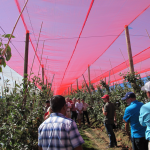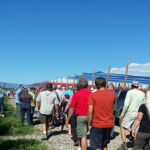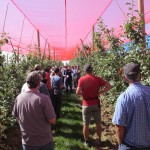Netting can protect your crop from hail, well worth the value when mother nature strikes. Photo-selective anti-hail nets can also provide additional value by reducing plant stress and sunburn. WSU’s Dr. Lee Kalcsits and Dr. Stefano Musacchi gave more than 90 field day participants an update last week on what they are learning about how different colors of anti-hail netting can reduce wind speed and light intensity and how this might impact tree growth and sunburn. 


Sunburn control is one of the big advantages of netting. In Eastern Washington, the light is intense. On a bright day it may reach 1,900 µmoles m-2 s-1 in the summer. Shade netting is designed to intercept some of this intense light. In WSU’s current study Kalcsits is working with a 20-25% shade netting. This is important because excess light heats up the fruit and can create sunburn. Fruit like soil and concrete absorb the energy from light and heat up. Kalcsits explains, “When you or I are sitting in the sun we heat up. But, we can sweat and cool ourselves. The tree leaves can do the same thing by transpiring and maintaining temperature. But fruit can not. Fruit surface temperature may be 20°F warmer than air temperature on a bright hot day.” Shade netting intercepts some of this intense light. With less energy hitting the fruit it does not heat up as much. In the first year of the study Kalcsits and Musacchi found fruit under the netting may be only 7 °F warmer than air temperature. That means for a day where the air temperature reaches 95 °F fruit surface temperatures of 100 °F under netting compared to fruit with no shade netting or evaporative cooling reaching 115 °F, a temperature where sunburn starts to occur. In 2015, fruit averaged 5-10% sunburn under netting compared to 25% sunburn in non-netted trees with no over head cooling.
In addition to changing the tree environment by reducing light intensity Kalcsits and Musacchi saw a 40% reduction in wind speed. Interestingly, shade netting did not reduce air temperature. “We were surprised,” Kalcsits said. Although it feels cooler when you walk under the net this is because there is less light hitting you and warming you up. “There was no significant difference in air temperature outside and inside the net.”
Netting can also reduce tree stress. Without netting, photosynthesis tends to drop dramatically after midday. To be able to grow, plants need to take up water from the soil and carbon dioxide from the atmosphere to use in photosynthesis. At high temperatures trees close the stomata in their leaves so that they lose less water to the air from transpiration. Closing stomata reduced water loss. However, with their stomata closed the leaves are absorbing less carbon dioxide which they need to produce carbohydrates. Under the netting the trees photosynthesize and make carbohydrates later into the day because they are not stressed. Musacchi and Kalcsits found significant increases in vertical growth and branching under netting. “In addition to sunburn protection another advantage is the increase in growth. We saw a 15% increase in canopy volume. This is important for Honeycrisp which tends to stop growing when there is fruit on the trees. Netting helps it keep growing,” Musacchi explained.
Different colors of netting modify the quality of light under the netting. Blue light is generally important for vegetative growth and red light, when combined with blue light encourages flowering and fruiting. In Europe researchers have found a reduction in return bloom and increase of fruit overcolor under red netting and increases in vegetative growth and vigor under blue light. Musacchi and Kalcsits are testing whether light color ratios will have significant impacts in Washington. “These effects are cumulative. It will take multiple years to see potential effects from netting color,” Kalcsits told the group.
Growing under netting does come with management considerations. It is important to open and close the net looking carefully for snow events. A late snow in spring or an early snow in winter can seriously damage the orchard structure. Also bees can be effected by netting so it is better to open the net after flowering is complete. It is also likely that managers will need to modify their irrigation patterns under nets because of changes in water-use.
Preliminary results from WSU’s netting research show potential advantages to photo-selective anti-hail netting. But time (and more data points) will tell. We will continue to keep you updated as we learn more about the effects of orchard overhead netting and how it can reduce tree stress and effect your bottom line. Keep a look out for a video coming out soon on this project.
Contacts
Assistant Professor,
Tree Fruit Physiology
Associate Professor,
Endowed Chair – Tree Fruit Physiology and Management
Tree Fruit Extension Specialist



